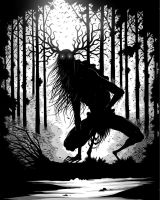Justin & Friends Chasing Monsters
- James D. A. Terry

- Aug 5, 2022
- 4 min read
Justin, Justin Case, Termination Agent for the Tin Can Communications Company and his friends seem destined to be monster hunters. Their first adventure finds them “Chasing the Wendigo”, an Algonquin legend of a nightmarish creature or is it that person standing beside you.
The legend describes the Wendigo as having pale ashy skin stretched tight and mummy-like over the jutting spurs of protruding bones; its glassy eyes glowing like hot coals from sunken black sockets and as vacant as they are brooding with evil. A visceral smell oozes from its flesh, rich with rot and fresh metallic blood, as the beast stalks its prey from a looming height of 15 feet in the inky darkness of the forest. This unsettling image damned the souls of those who claim to have faced the creature in the flesh, so to speak.
Then again, there are those living among us infected by a corrosive drive toward self-aggrandizing greed and excessive consumption, traits that sow disharmony and destruction. Agents of social cannibalism who know no restrictions, expressing the darkest aspects of human nature; these are the true WENDIGOS that walk among us. It will be the person you least suspect, someone you know or the person standing next to you in line, perhaps someone you know.
Be sober, be vigilant: because your adversary, the devil, as a roaring lion, walketh about seeking whom he may devour. 1 Peter 5:8 KIV
"Chasing the Golem," Justin and his friends’ next mission, should they accept it, will be the pursuit of a fascinating creature of Jewish mysticism and folklore. The name “Golem” is thought to be derived from the Hebrew word for an incomplete being or project. This makes sense for a creature that is created from clay by the hands of humans through magic and not by the hands of God. Although rather dumb, in most legends the Golem is extremely powerful. Whether a Golem is good or evil, though, is a far more complicated question. There is so much more to this monster to uncover!
The 1960s was a new era for Hollywood, with the studio system broken and a catalogue of filmmakers breaking through with European inspired cinema. Along with industry changes, the America of the 60s had rising tensions overseas and at home in regards to the Cold War, Vietnam War, and Civil Rights Movement. These issues leaked into American cinema, specifically the horror genre.
While 1950s horror was ripe with alien invasions and radioactive monsters, the 1960s turned away from these narratives in favour of psychological thrillers. One of the most prominent filmmakers of the time was director Alfred Hitchcock. Many of his movies prior to the 60s were suspense films. However, his 1960 film Psycho ushered in one of the first slasher movies and marked the direction many scary movies would take in the ensuing years.
Instead of featuring something supernatural or scientific, Psycho focused on a human killer who is mentally disturbed. This movie paved the way for more on screen violence in American cinema, something that would be evident in the 1970s. Along with graphic violence, the movie played up the horror of being watched.
There seemed to be a fascination with exploiting the trauma of women, as seen in the two films mentioned above as well Roman Polanski's Repulsion and Rosemary's Baby. In the case of Polanski, who is a convicted child rapist, and Hitchcock, who sexually harassed actress Tippi Hedren on set, this could be a reflection of the dark reality of Hollywood.
Rosemary's Baby in particular has a woman lead the film, exploring issues about emotional abuse, rape, and pregnancy. While these subjects could not be explored in such depth years prior, the 1960s had filmmakers push for more controversial material, and these issues were being tackled in reality with the Second Wave of Feminism.
This film is also one of several horror movies that went back to using supernatural elements, something that had been pushed aside in favour of science-fiction in the 1950s. 1963's The Haunting and 1961's The Innocents are key examples of this, however, in the case of these films; the horror was not about the paranormal but about the mental decline of their characters.
The 1960s were finding their own horror stories to tell with new fears percolating in society, but the tensions surrounding the Cold War were still present. While 60s horror films were not focusing on science-fiction, fear of invasion was prominent. This mixed with rising internal tensions about the Vietnam War and Civil Rights Movement led to a boom in films that focused on how people responded to "invasions."
The best example of this is Night of the Living Dead. After the dead come back to life, a group of survivors must work together to get away from the impending threat, however, internal tensions lead to a divide amongst the group and in turn their deaths, commenting on the societal divide during the 60s.
Both the film industry and American society at large were changing during the 60s. With the vestiges of the McCarthy Era present and America divided over issues about gender, race and war, horror movies used the psychological and supernatural to address national anxieties. Where some films were a horrific glimpse into the dark truth about Hollywood, others catapulted conversations in ways that would impact future film-making.










Very interesting.